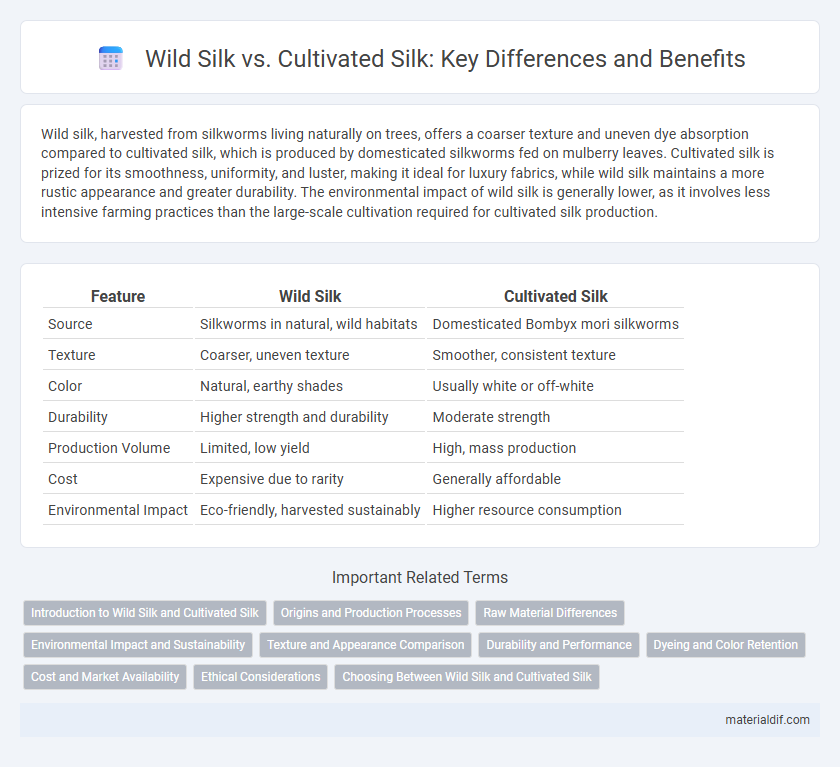Wild silk, harvested from silkworms living naturally on trees, offers a coarser texture and uneven dye absorption compared to cultivated silk, which is produced by domesticated silkworms fed on mulberry leaves. Cultivated silk is prized for its smoothness, uniformity, and luster, making it ideal for luxury fabrics, while wild silk maintains a more rustic appearance and greater durability. The environmental impact of wild silk is generally lower, as it involves less intensive farming practices than the large-scale cultivation required for cultivated silk production.
Table of Comparison
| Feature | Wild Silk | Cultivated Silk |
|---|---|---|
| Source | Silkworms in natural, wild habitats | Domesticated Bombyx mori silkworms |
| Texture | Coarser, uneven texture | Smoother, consistent texture |
| Color | Natural, earthy shades | Usually white or off-white |
| Durability | Higher strength and durability | Moderate strength |
| Production Volume | Limited, low yield | High, mass production |
| Cost | Expensive due to rarity | Generally affordable |
| Environmental Impact | Eco-friendly, harvested sustainably | Higher resource consumption |
Introduction to Wild Silk and Cultivated Silk
Wild silk originates from silkworms that grow naturally on forest trees, producing silk fibers known for their rougher texture and unique natural coloration. Cultivated silk comes from domesticated silkworms, primarily Bombyx mori, selectively bred for smoother, finer fibers and consistent quality. Differences in habitat and rearing methods impact the texture, appearance, and durability of wild and cultivated silk fabrics.
Origins and Production Processes
Wild silk originates from silkworms that feed on various forest trees, producing fibers with natural variations in texture and color, while cultivated silk is derived from the domesticated Bombyx mori silkworm, primarily fed mulberry leaves for uniform, fine strands. The production process of wild silk involves gathering cocoons from natural habitats, often requiring specialized techniques to manage the irregular fiber quality and limited quantity. Cultivated silk production is a controlled agricultural practice emphasizing sericulture, with standardized methods for harvesting, reeling, and spinning to ensure consistent silk quality and large-scale output.
Raw Material Differences
Wild silk is produced by silk moths living in natural habitats, resulting in fibers with irregular texture and natural pigments, whereas cultivated silk comes from domesticated Bombyx mori larvae feeding on mulberry leaves, yielding smoother, more uniform fibers. The raw material of wild silk contains higher sericin content and naturally occurring impurities, influencing its durability and color variations. Cultivated silk's raw material is more refined due to controlled feeding and environmental conditions, ensuring consistency in fiber quality and appearance.
Environmental Impact and Sustainability
Wild silk production relies on silkworms that feed on native trees and thrive in natural habitats, resulting in minimal environmental disruption and maintaining biodiversity. Cultivated silk, produced through controlled sericulture, often involves intensive farming practices that can lead to deforestation, pesticide use, and higher water consumption. Wild silk's eco-friendly harvesting methods and organic lifecycle make it a more sustainable choice compared to the environmental footprint of large-scale cultivated silk farming.
Texture and Appearance Comparison
Wild silk features a coarser texture with a natural, uneven surface that lends a rustic appearance, often showcasing variations in color due to its organic production process. Cultivated silk, refined through controlled sericulture, offers a smooth, lustrous texture and uniform sheen, resulting in a polished and consistent appearance preferred in luxury textiles. The distinct tactile and visual qualities of wild silk make it ideal for artisanal and eco-friendly products, while cultivated silk dominates high-end fashion and premium upholstery.
Durability and Performance
Wild silk, derived from silkworms living in natural habitats, exhibits higher durability due to its coarser fibers and denser texture, making it more resistant to wear and tear. Cultivated silk, produced from domesticated Bombyx mori silkworms, offers superior uniformity and smoothness but tends to be less resilient under heavy use. Performance-wise, wild silk excels in rugged applications requiring strength, while cultivated silk suits delicate fabrics demanding a finer finish.
Dyeing and Color Retention
Wild silk fibers tend to have a natural yellowish or brownish hue that can affect dye uptake, resulting in more muted and less consistent colors compared to cultivated silk. Cultivated silk, primarily from Bombyx mori, has a smoother, more uniform fiber structure that allows for even dye penetration and vibrant, longer-lasting color retention. The higher sericin content in wild silk also impacts dye fixation, often requiring specialized mordants to achieve desired shades and durability.
Cost and Market Availability
Wild silk typically costs more than cultivated silk due to its limited supply and labor-intensive harvesting process. Cultivated silk dominates the market because it benefits from large-scale production and consistent quality, making it more widely available and affordable. The niche demand for wild silk sustains its premium price despite lower market availability.
Ethical Considerations
Wild silk is often praised for its ethical advantages as it is harvested without killing silkworms, allowing them to complete their natural life cycle, whereas cultivated silk typically involves boiling silkworms alive to extract fibers. The ecological impact of wild silk is generally lower, with less chemical use and habitat disruption compared to large-scale farming for cultivated silk. Consumers seeking cruelty-free and sustainable textile options increasingly prefer wild silk due to these ethical and environmental benefits.
Choosing Between Wild Silk and Cultivated Silk
Choosing between wild silk and cultivated silk depends on the desired texture, durability, and environmental impact. Wild silk, such as tussar or eri, offers a coarser texture with natural variations and greater sustainability due to its organic harvesting methods. Cultivated silk, primarily mulberry silk, provides a smoother, more uniform fabric favored for luxury textiles but involves more intensive cultivation and processing.
Wild silk vs Cultivated silk Infographic

 materialdif.com
materialdif.com